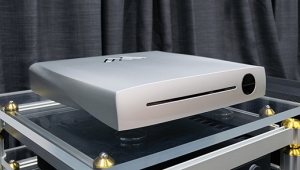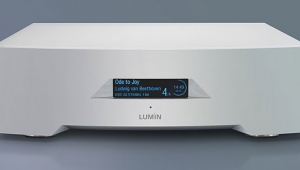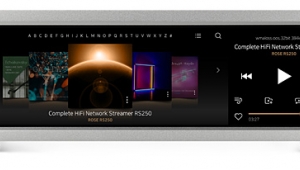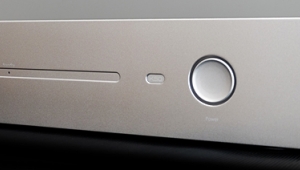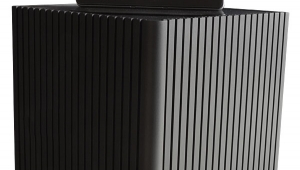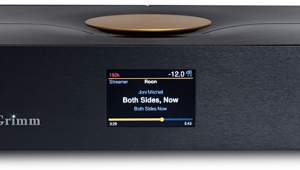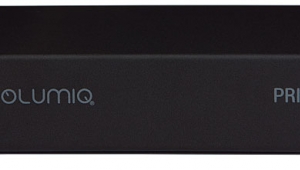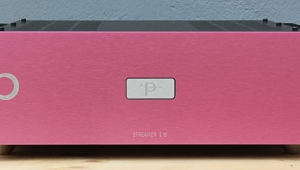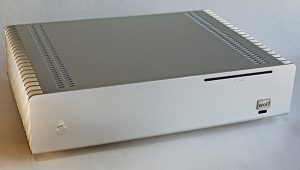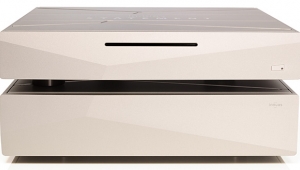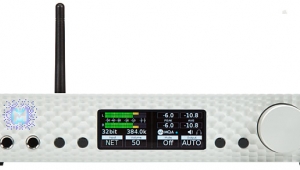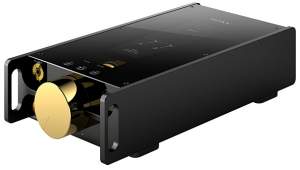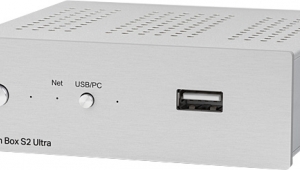| Columns Retired Columns & Blogs |
Sonos ZP80 & ZP100 WiFi Music System Sonos Bundle 250, April 2010
John Atkinson wrote about the Sonos ZP120 in April 2010 (Vol.33 No.4):
Footnote 1: Overviews of the current Sonos Bundle 150 and Bundle 250 systems can be found in the November 2009 and January 2010 issues of our sister magazine Home Theater.—John Atkinson
In the October 2006 issue of Stereophile I enthusiastically reviewed two network-connected music players from California company Sonos: the ZP80 D/A processor, which offers both S/PDIF digital outputs and line-level analog outputs, and the ZP100 D/A integrated amplifier. Used with a Sonos controller, these Zone Players allow you to create a multiroom system that will play music files stored on a host PC, Internet radio stations, or streaming music services such as Pandora and Rhapsody. (Trial-period subscriptions to these services are included with the Sonos purchase price.) Unlike computer-based networked music systems, you don't have to get in touch with your inner geek to set up a Sonos system. Rather than plug'n'pray, they're truly plug'n'play (footnote 1).
Following my review, Sonos introduced an app for the iPhone that allowed the latter to control a Sonos system; then, in fall 2008, new hardware. The ZP90 replaces the ZP80, and seems to differ from its predecessor primarily in its ability to handle a more robust wireless network protocol. I used its digital output to feed the high-end processor in my big rig—a dCS Puccini—with superb results, though it is limited to 44.1kHz and 48kHz-sampled data. However, while the ZP120 resembles the ZP100 in using a class-D output stage, it offers slightly more power—55Wpc into 8 ohms compared with 50Wpc—and replaces the earlier unit's linear power supply with a switching supply. It also offers more robust wireless networking capabilities.
Commendably, prices for the new models are the same as for the originals: $349 for the ZP90, $499 for the ZP120. The more recent CR200 touchscreen controller is cheaper, at $349 vs $399, and now, to maximize battery life, has a motion sensor: it wakes up only when you pick it up. For this Follow-Up, Sonos sent me their Bundle 250 ($999), which includes the minimum setup for a two-room system: a ZP90, a ZP120, and a controller. They also offer the BR100 ZoneBridge ($99), which can be attached to your router or Networked Attached Storage drive (NAS drive) in place of a ZP90 or ZP120, to maximize system flexibility.
For the purposes of this Follow-Up, I examined the Sonos ZP120's measured behavior using mainly Stereophile's loan sample of the top-of-the-line Audio Precision SYS2722 system (see the January 2008 "As We See It" and www.ap.com); for some tests, I also used my vintage Audio Precision System One Dual Domain. I mainly used the ZP120's line input for the testing, and repeated some tests using WAV files played back from my Mac mini via the Sonos wireless network.

Fig.1 Sonos ZP120, THD+N (%) against power (W) into 8, 4, and 2 ohms.
The ZP120 is limited to sample rates of 44.1 and 48kHz, but its gain architecture is well managed, a 1kHz tone at 0dBFS just driving the amplifier into clipping. Backing off the volume control by one click gave an output of exactly 55Wpc into 8 ohms at 0.018% THD+noise, which is the specified maximum power (17.4dBW). Fig.1 plots the ZP120's THD+N percentage against power into 8, 4, and 2 ohms. No less than 127Wpc were available at clipping into 4 ohms, though the amnplifier turned off at just over 100W into 2 ohms. (It didn't suffer any damage, however.) The line input overloaded at 2.2V, which is typically the maximum level from a CD player, so the ZP120's line input shouldn't overload with such sources. However, as the overload occurs before the ZP120's volume control, make sure any auxiliary analog sources you use don't peak above 2.2V.

Fig.2 Sonos ZP120, line-input frequency response at 2.83V into: simulated loudspeaker load (gray), 8 ohms (left channel blue, right red), 4 ohms (left cyan, right magenta), 2 ohms (green). (0.5dB/vertical div.)
The line input impedance was a usefully high 41k ohms at low and middle frequencies, dropping inconsequentially to 37k ohms at 20kHz. The ZP120's output preserved absolute polarity (ie, was non-inverting) for both analog and digital inputs. The amplifier's output impedance was a low 0.18 ohm at 20Hz and 1kHz, but rose to 2 ohms at 20kHz, presumably due to the presence of a passive low-pass filter at the ZP120's output terminals, to reduce the level of switching noise. This filter appears to be optimized for a 4 ohm speaker load, as the small-signal response is at its flattest into that impedance. The response peaks by up to 1.6dB in the top octave both into 8 ohms (fig.2, blue and red traces) and into our standard simulated loudspeaker (gray), but rolls off prematurely into 4 ohms (green), reaching –3dB at 16kHz.

Fig.3 Sonos ZP120, small-signal 10kHz squarewave into 8 ohms.

Fig.4 Sonos ZP120, small-signal 1kHz squarewave into 8 ohms.
The response into all loads drops off very sharply above 20kHz, making a 10kHz squarewave fed into the line input resemble a sinewave (fig.3). In fact, looking at the waveform of a 1kHz signal (fig.4), this features the symmetrical Gibbs Phenomenon "ringing" typical of a very-high-order low-pass filter. It appears that the ZP120 digitizes its line-level input, which explains why the input overloads sharply at 2.2V, the maximum level the A/D converter can handle.
Channel separation (not shown), measured with an audioband low-pass filter, was excellent, at >100dB R–L and >92dB L–R below 2kHz, and still 80dB at 20kHz. Because the ZP120's output stage runs in class-D, even with the output filter there is still quite a high level of high-frequency switching noise present at the speaker terminals; I measured 205.3mV with a center frequency around 625kHz without any signal being reproduced. This noise will drive the analyzer's input stage into slew-rate limiting. To test the ZP120's distortion, therefore, I used the auxiliary passive audioband filter supplied by Audio Precision for use when testing switching amplifiers. This filter goes between the speaker load and the Audio Precision's input terminals; it reduced the noise from 205.3mV to just 4mV.

Fig.5 Sonos ZP120, THD+N (%) vs frequency with AP low-pass filter at 6.3V into: 8 ohms (left channel blue, right red), 4 ohms (left cyan, right magenta), 2 ohms (green).
Fig.5 shows how the ZP120's THD+N percentage varies with frequency at a moderate output level equivalent to 5.5W into 8 ohms. Other than a very slight rise in the top octaves, the distortion doesn't vary significantly with frequency, and is actually lower into 4 ohms (cyan and magenta traces) than into 8 ohms (blue and red). However, it rises considerably into 2 ohms (green).

Fig.6 Sonos ZP120, 1kHz waveform at 28W into 4 ohms with AP low-pass filter (top), 0.042% THD+N; distortion and noise waveform with fundamental notched out (bottom, not to scale).

Fig.7 Sonos ZP120, spectrum of 50Hz sinewave with AP low-pass filter, DC–1kHz, at 29W into 4 ohms (left channel blue, right red; linear frequency scale).
Even with the Audio Precision low-pass filter, this graph is still dominated by noise into the higher impedances and at a much higher power, the distortion residual (fig.6) is still overlaid with noise, though it can be seen to be primarily the benign second harmonic, which is confirmed by FFT analysis (fig.7).
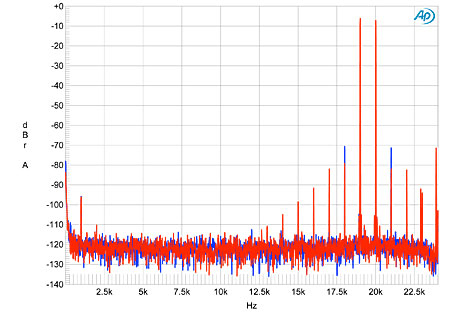
Fig.8 Sonos ZP120, HF intermodulation spectrum with AP low-pass filter, DC–24kHz, 19+20kHz at 21.5W peak into 4 ohms (linear frequency scale).
Finally, the ZP120 did well on the demanding high-frequency intermodulation test, which can be the Achilles' heel of a class-D amplifier. Fig.8 shows that the 1kHz difference component resulting from an equal mix of 19 and 20kHz tones lay at a very low –96dB (0.0015%), though the higher-order components at 18 and 21kHz lay at –70dB (0.03%).
The ZP120 measures well for an amplifier with a class-D output stage, and is a fitting successor to the ZP100. I can continue my enthusiastic recommendation of the Sonos approach to multiroom music reproduction.—John Atkinson
Footnote 1: Overviews of the current Sonos Bundle 150 and Bundle 250 systems can be found in the November 2009 and January 2010 issues of our sister magazine Home Theater.—John Atkinson
- Log in or register to post comments
